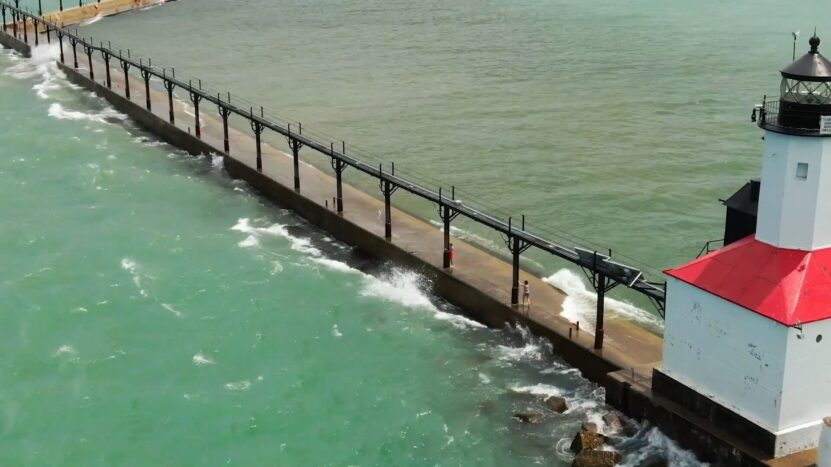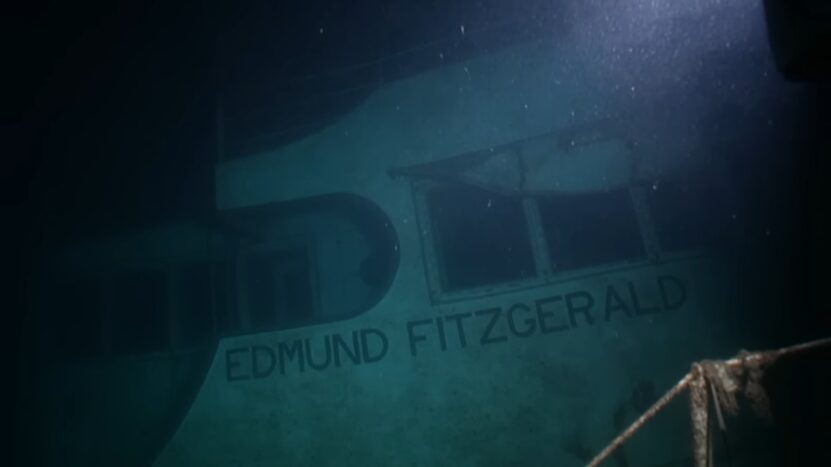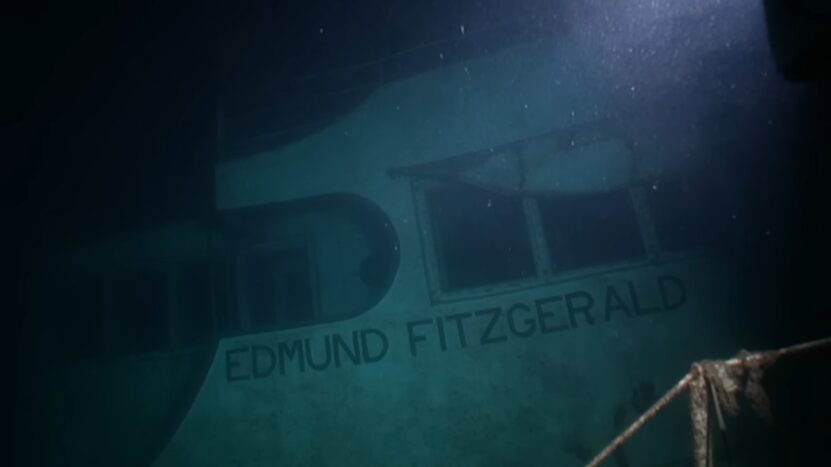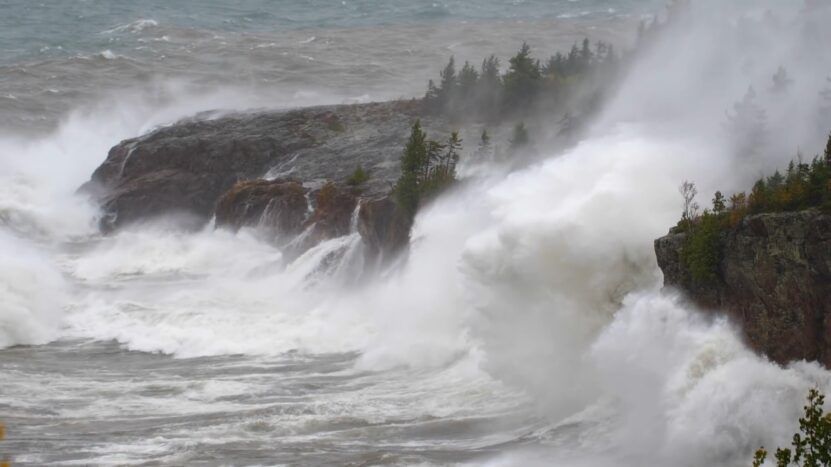Danger on North America’s largest Great Lake is a constant concern. Sudden and severe weather changes, strong currents, and icy temperatures create a hazardous environment. The lake’s sheer size amplifies the effects of storms, while its cold depths can quickly lead to hypothermia.
Human factors, such as overconfidence and negligence, further increase the risk. Exploring these elements reveals why caution and preparation are vital for anyone venturing onto Lake Superior.
| Location | Bordered by Canada (Ontario) and the United States (Minnesota, Wisconsin, Michigan) |
| Surface Area | 31,700 square miles (82,103 square kilometers) |
| Maximum Depth | 1,332 feet (406 meters) |
| Average Water Temperature | 40°F (4°C) |
| Wave Heights | Can reach up to 20 feet (6 meters) during storms |
| Key Hazards | Unpredictable weather, strong currents, cold temperatures, and human negligence |
| Historical Tragedies | Numerous shipwrecks and drownings over the years |
Unpredictable Weather Conditions
Lake Superior’s weather conditions are famously unpredictable, contributing significantly to its hazardous nature. The lake’s vast surface area allows for sudden and severe weather changes, posing a constant threat to those navigating its waters.
Sudden Storms

One of the most notorious storms on Lake Superior occurs in November, known as the “Gales of November.” These storms have been historically significant, including the one on November 10, 1975, which sank the SS Edmund Fitzgerald, resulting in the loss of all 29 crew members.
Such storms are characterized by strong low-pressure systems that bring powerful winds and massive waves. On November 30, 2019, a severe storm produced waves that toppled a sea stack along Minnesota’s North Shore by the next morning.
Large Waves
During severe storms, Lake Superior can generate waves reaching up to 20 feet in height. These waves, often driven by strong northeasterly winds, are not only a spectacle but also a significant danger to vessels and shorelines.
In April 2023, a winter storm caused massive waves that crashed against the cliffs at Tettegouche State Park, encasing trees in ice and making conditions treacherous for any activity on or near the lake.
Rapid Weather Shifts
The lake’s location means it is influenced by various weather systems, leading to extreme weather changes. For instance, in June 2024, a storm produced heavy rain, frequent lightning, a confirmed tornado, and even a waterspout over Lake Superior between Tofte and Lutsen. Such rapid shifts can turn a calm day into a dangerous situation within minutes.
Seasonal Variations
Different seasons bring distinct challenges. In winter, Lake Superior becomes particularly perilous due to ice formation and extremely cold temperatures, which can cause hypothermia quickly. Even in summer, the water remains cold enough to shock swimmers and boaters unprepared for the lake’s frigid conditions.
Powerful Currents and Waves
Lake Superior is well-known for its powerful currents and waves, which contribute significantly to its dangerous reputation. These natural forces can pose serious risks to both experienced sailors and casual swimmers.
Rip Currents

Rip currents are strong, narrow currents that flow from the shore back out to deeper water. They are common in Lake Superior and can quickly pull swimmers away from the shore, making it difficult to return to safety. These currents are especially dangerous because they can form unexpectedly and are often hard to spot from the surface. Swimmers caught in a rip current are advised to swim parallel to the shore to escape its pull, rather than trying to swim directly back to the shore.
Longshore Currents
Longshore currents move parallel to the shore and can also pose dangers, particularly to inexperienced swimmers and boaters. These currents are driven by waves hitting the shore at an angle, creating a flow that moves along the coastline. While not as immediately life-threatening as rip currents, longshore currents can disorient swimmers and make it difficult to reach safety.
Wave Heights
Lake Superior’s vast size allows for the formation of large waves, especially during storms. The fetch, or the distance over which wind blows across open water, contributes to the size and power of these waves.
During severe weather, waves on Lake Superior can reach heights of up to 20 feet. These massive waves are capable of capsizing boats and overwhelming even large vessels. For instance, in April 2023, a winter storm generated waves that crashed against cliffs and shorelines, creating treacherous conditions and causing significant damage.
Tidal Action
Although not tidal in the same way as oceans, Lake Superior experiences seiches, which are standing waves that oscillate in the lake, often caused by atmospheric pressure changes or wind. These can lead to sudden and unpredictable changes in water levels, further complicating navigation and increasing the risk for boaters and swimmers.
Frigid Water Temperatures
One of the most persistent and perilous features of Lake Superior is its frigid water temperatures. Regardless of the season, the lake’s water remains cold enough to pose significant risks to anyone who comes into contact with it.
Consistently Cold Waters
Even in the peak of summer, Lake Superior’s water temperature rarely exceeds 40°F (4°C). This is due to the lake’s immense depth and volume, which allows it to retain cold temperatures throughout the year. The cold water can cause hypothermia in a matter of minutes, making it dangerous for swimmers, boaters, and anyone who might fall into the lake.
Hypothermia Risks
Hypothermia occurs when the body loses heat faster than it can produce it, causing a dangerously low body temperature. In the frigid waters of Lake Superior, hypothermia can set in within minutes.
This rapid onset can impair a person’s ability to swim or call for help, significantly increasing the risk of drowning. The cold shock response, which includes involuntary gasping and hyperventilation, can also lead to drowning if it causes a person to inhale water.
Impact on Rescue Operations
The cold water temperatures also impact rescue operations. Rescuers need to act quickly to prevent hypothermia in individuals who have fallen into the lake. However, the cold can also affect the rescuers themselves, making it challenging to conduct prolonged search and rescue missions. This urgency underscores the importance of immediate and effective emergency response measures around Lake Superior.
Seasonal Variations
During the winter months, the surface of Lake Superior can freeze over in some areas, creating additional hazards. Ice cover can be unstable and unpredictable, posing risks for those who venture out onto it. Additionally, the cold air temperatures in winter can exacerbate the dangers of hypothermia, as both air and water temperatures plunge well below freezing.
Vast Size and Depth
Lake Superior’s immense size and depth contribute significantly to its dangerous reputation. These characteristics create unique challenges for navigation, weather patterns, and rescue operations.
Immense Size
Covering approximately 31,700 square miles (82,103 square kilometers), Lake Superior is the largest freshwater lake by surface area in the world. Its vast expanse means that storms can develop and move across the lake without warning, catching boaters and swimmers off guard. The size also allows for large waves to build up over long distances (fetch), increasing their height and power.
Deep Waters
With a maximum depth of 1,332 feet (406 meters), Lake Superior is also the deepest of the Great Lakes. The depth contributes to the lake’s cold temperatures, as the deep water retains cold even during warmer months. This depth can also complicate rescue operations, as it makes underwater searches more difficult and time-consuming.
Navigation Challenges
Navigating Lake Superior requires careful planning and respect for its size. The vastness can be disorienting, and many parts of the lake are remote, with limited access to help in case of an emergency. Mariners must be skilled in navigation and aware of the lake’s changing conditions to safely traverse its waters.
Historical Shipwrecks

Lake Superior’s size and depth have been factors in many historical shipwrecks. The lake’s harsh conditions have led to over 350 documented shipwrecks, including famous ones like the SS Edmund Fitzgerald. These shipwrecks serve as a stark reminder of the lake’s power and the importance of respecting its vast and often treacherous waters.
Weather Patterns
The size of Lake Superior allows it to generate its own weather patterns, which can be unpredictable and severe. The lake can influence local climates, creating sudden fogs, intense storms, and high winds. These weather patterns can change rapidly, posing risks to those on or near the lake.
Human Factors and Negligence
While Lake Superior’s natural conditions make it inherently dangerous, human factors and negligence often exacerbate the risks. Overconfidence, lack of preparation, and irresponsible behavior can lead to tragic outcomes on the lake.
Overconfidence and Inexperience
Many accidents on Lake Superior result from individuals underestimating the lake’s power. Overconfidence in one’s abilities, especially among inexperienced boaters and swimmers, can lead to dangerous situations. The lake’s calm appearance can be deceiving, and those who are not prepared for sudden changes in weather or water conditions may find themselves in peril.
Negligent Boating Practices
Irresponsible boating practices, such as not wearing life jackets, operating vessels under the influence of alcohol, and ignoring weather warnings, significantly increase the risk of accidents. Proper safety protocols are often neglected, leading to preventable tragedies.
The combination of high waves, strong currents, and cold water can quickly turn a minor oversight into a life-threatening situation.
Lack of Safety Equipment
Failing to carry essential safety equipment is another critical factor. Boaters and swimmers need to be equipped with life vests, emergency radios, and first aid kits. Proper navigation tools such as GPS systems and marine radios are also crucial for ensuring safety on the vast lake.
Many accidents could be avoided if individuals took the necessary precautions and prepared adequately for their outings.
Inadequate Knowledge of the Lake
Understanding the unique dangers of Lake Superior is essential for safety. Many incidents occur because individuals are unaware of the lake’s specific hazards, such as its powerful currents and sudden storms.
Education and awareness campaigns can help mitigate these risks by informing the public about the necessary precautions and best practices for safely enjoying the lake.
Historical Incidents
Numerous historical incidents highlight the role of human error in Lake Superior’s dangers. The sinking of the SS Edmund Fitzgerald is one of the most famous examples, where a combination of severe weather and potential human errors led to the loss of the entire crew.
This tragedy underscores the importance of respecting the lake’s power and being thoroughly prepared for its unpredictable conditions.
Tragedies and Shipwrecks
Lake Superior has witnessed numerous maritime disasters, earning it a reputation for being perilous. These historical tragedies serve as stark reminders of the lake’s dangers.
The SS Edmund Fitzgerald

One of the most infamous shipwrecks on Lake Superior is the sinking of the SS Edmund Fitzgerald. On November 10, 1975, the ore freighter encountered a severe storm with wind speeds exceeding 60 mph and waves as high as 35 feet. The ship sank suddenly, resulting in the loss of all 29 crew members. This disaster highlights the lethal combination of extreme weather and the lake’s powerful waves.
The Great Storm of 1905
Known as the Mataafa Storm, the Great Storm of 1905 struck Lake Superior in late November, causing extensive damage. This storm destroyed or damaged 29 ships and resulted in 78 fatalities. The harsh conditions included freezing temperatures, strong winds, and massive waves, demonstrating the severe dangers of late fall on the lake.
Shipwreck Coast
The southeastern shore of Lake Superior, particularly near Whitefish Bay, is notoriously known as Shipwreck Coast. This area has seen numerous shipwrecks due to its treacherous waters and frequent storms. The Whitefish Point Light Station and the Great Lakes Shipwreck Museum document the many vessels lost in this perilous region.
Recent Incidents
In recent years, Lake Superior has continued to be dangerous. Between 2018 and 2021, the lake claimed the lives of several kayakers, primarily due to unexpected weather changes and the cold water temperatures that can quickly incapacitate individuals. These incidents underscore the ongoing risks present on Lake Superior.
Last Words
Lake Superior’s inherent dangers stem from its unpredictable weather, powerful currents, cold temperatures, and vast size. These factors have led to numerous shipwrecks and tragedies over the years. To ensure safety, anyone venturing onto or near the lake must be well-prepared and respect its natural hazards.

